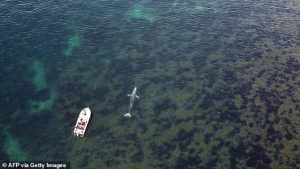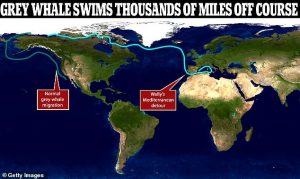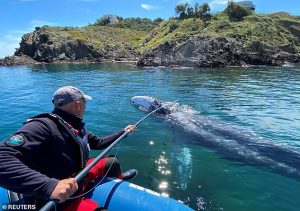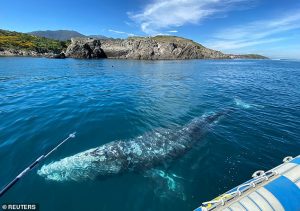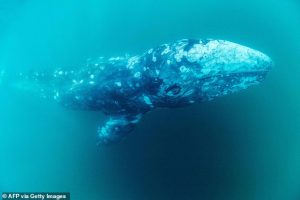- A two-year-old grey whale is lost in the Mediterranean due to global warming
- Experts say a warming world has opened northern routes in the Arctic
- The whale, dubbed Wally, should have migrated to the Pacific Ocean
- Instead, the whale took the wrong route and is traveling through Europe
- Biologists fear Wally will die due to a lack of normal food sources
- This is the second grey whale to take the wrong route when migrating
A grey whale is swimming thousands of miles from its normal migrate and experts say global warming is to blame.
Dubbed Wally, the two-year-old whale is said to be lost in the Mediterranean after a warming world opened northern routes in the Arctic.
Biologists are working tirelessly to help relocate Wally over fears he cannot find the invertebrates that are his normal food source in the depths of the Pacific Ocean.
‘We are very worried about his future, as his fat, which is his fuel to travel, has gone down a lot,’ said Eric Hansen, head of the state biodiversity agency in southern France.
‘He is exhausted and just skin over bones. We have not seen him eat since we started tracking him.’
Global warming is increase temperatures worldwide, but the Arctic is feeling the brunt and losing much of its treasured sea ice.
As ice disappears, passages open for marine animals to travel between the Pacific Ocean and Atlantic Ocean.
However, some marine animals, like Wally, are become confused and taking the wrong route when it is time to migrate.
Wally is believed to have taken the Gibraltar Strait to the Mediterranean and followed the Moroccan coast before traveling across Italian shores and landing in France where Hansen and his team spotted him.
The whale is swimming 50 to 60 miles per day and is quickly approaching the Spanish coast, which could spell more trouble for the young mammal.
‘It is trying to enter harbors, as if to find a way out. Its strategy should work and we hope it can make its way back to Gibraltar in about a week,’ Hansen said.
He has already been captured in a fishing net off the Camargue coast, but managed to free himself.
It is only the second time biologists have observed a grey whale in the Mediterranean. The last time was in 2010.
‘We will probably see this more often because of climate change, which not only opened the northern route but is also changing ocean currents because of the melting of the ice caps,’ Hansen said.
The grey whale that ventured into the Mediterranean more than 10 years ago was a 33-foot long mammal that was first sighted off Herzliya in central Israel
Biologists fear the young whale may not be so lucky if he travels through the heavy ship traffic in the Gibraltar Strait.
Dr Aviad Scheinin, chairman of the Israel Marine Mammal Research and Assistance Centre which identified the creature, told AFP: ‘It’s an unbelievable event which has been described as one of the most important whale sightings ever.’
‘Here you have an animal that is supposed to live in the Pacific and because the ice in the Arctic is melting, it managed to get through this corridor near the Bering Strait,’ he said.
The theory is that it was part of a group heading north toward Alaska as they migrated from Baja California. Then as a result of the decreasing ice cover which means the North-West Passage is opening up it kept on going before heading south into the Atlantic.
Source: https://www.dailymail.co.uk/








